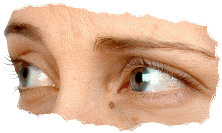Vision
Vision is a vastly complicated highly organized living electrical machine.
It produces an ultra high resolution three dimensional moving color picture with instant automatic focus, instantaneous execution with no perceptible delay between the occurrence and the perception, low light compensation, a mechanism for self-repair, self-defense against infection, and nerves that create the exactly the right amount of electricity necessary to transmit coded signals from the eye to the brain.
 The brain receives the code transmitted by 126,000,000 constantly changing optic nerves (based on approximately 63,000,000 in each eye. So, each nerve transmits 1/63,000,000th of the "picture" that is focused on the retina at any one moment. And each time the eyes move, all 126,000,000 codes instantly change.
The brain receives the code transmitted by 126,000,000 constantly changing optic nerves (based on approximately 63,000,000 in each eye. So, each nerve transmits 1/63,000,000th of the "picture" that is focused on the retina at any one moment. And each time the eyes move, all 126,000,000 codes instantly change.
The means by which vision is transmitted from the eye to the brain is a code that is expressed by the electrical impulses that travel along the optic nerve. That is, the retina places what it sees into the form of codes and these codes are transmitted along the optic nerve to the brain. The brain receives untold masses of encoded information from the eyes and deciphers it in a matter of nanoseconds to create the awareness that we know as vision.
The retina also engages in the translation of the scene as a whole because it preprocesses the signals that it sends to the brain. So, the retina and the visual cortex in the brain are not simply the receptor and the translator, they are a single whole and they act in concert.
"The first stage of visual processing begins in the eye where the retina transforms patterns of incident light intensity into trains of impulses in optic nerve fibers. The retina can encode information in a reliable and efficient manner, but does not encode all of it. Rather the retina emphasizes certain features in the visual scene at the expense of others, presumably to help animals find food, locate mates, and avoid predators. Knowing what an animal can see is crucial for exploring the neural code the eye transmits to the brain."
Passaglia, Christopher; Dodge, Frederick; Herzog, Erik; Jackson, Scott, Deciphering a Neural Code for Vision, Proc. Natl. Acad. Sci. USA, Vol. 94, pp. 12649-12654, November 1997.
The retina preprocesses images into least 12 different streaming motion pictures, each one transmitting only its assigned part of vision. For instance, one is a code that represents the edges and defines exactly where they are in relation to the rest of what is seen. There is another that encodes the shadows and another the highlights and the rest represent 9 other separate and discrete portions of constantly changing images that are focused on the retina. Each of these streaming motion pictures must be written into the digital code that will be utilized to transfer it to the brain. The brain must be programmed to read the code and assemble and superimpose the 12 changing tracks and instantly create an essentially flawless three dimensional color representation of a reality to which it is not connected:
"Overall, we have found that specialized nerve cells, or neurons, deep within the retina project what can be thought of as a dozen movie tracks - distinct abstractions of the visual world. Each track embodies a primitive representation of one aspect of the scene that the retina continuously updates and streams to the brain. One track for example, transmits a line-drawing line image that detains only the edges of objects. Another responds to motion, often in a specific direction. Some tracks carry information about shadows or highlights. The representations of still other tracks are difficult to categorize.
Each track is transmitted by its own population of fibers within the optic nerve to higher visual centers in the brain, where even more sophisticated processing takes place ..."
The Movies in Our Eyes, Werblin, Frank and Roska, Botond, Scientific American, April 2007, p 73
According to Passaglia, the retina is programmed to identify certain forms as important and encodes them in "bold print" so to speak.
For instance, in Passaglia's experiment, the retina in a male horseshoe crab is programmed to recognize the code that transmits an image of a female horseshoe crab to the brain - and emphacize it. How did certain neurons become "dedicated" so to speak to encode only certain portions of a scene so that when they all act together the create essentially a flawless representation of outside reality? The neurons of the retina are not learning mechanisms, they don't learn how to transmit only a portion of what is seen. They come that way; that is the way they function from the first. And the retinas of horseshoe crabs encode an emphasis on mates and predators. That is the way they are formed. How did this happen? Did the level of this perfection really occur through happenstance, random beneficial mutations and dying animals? Can we really see more than 16,000,000 different colors because unobserved accidental changes (that are still supposed to be happening today) made us better and better until we could see them all - with each color defined by an electrical code?
Evolution's tired response that everything just got better and better by accidental mutations until we had the vision that is described here. This is no explanation at all. The truth is that there is a clear and unmistakable design here that far exceeds what could ever have been accomplished by accidental mutations and survival of the fittest. There is an intentional design here.